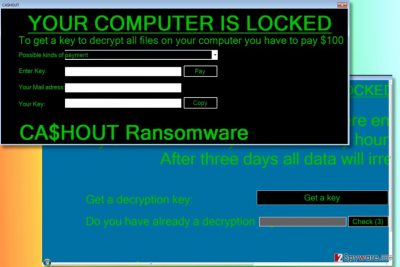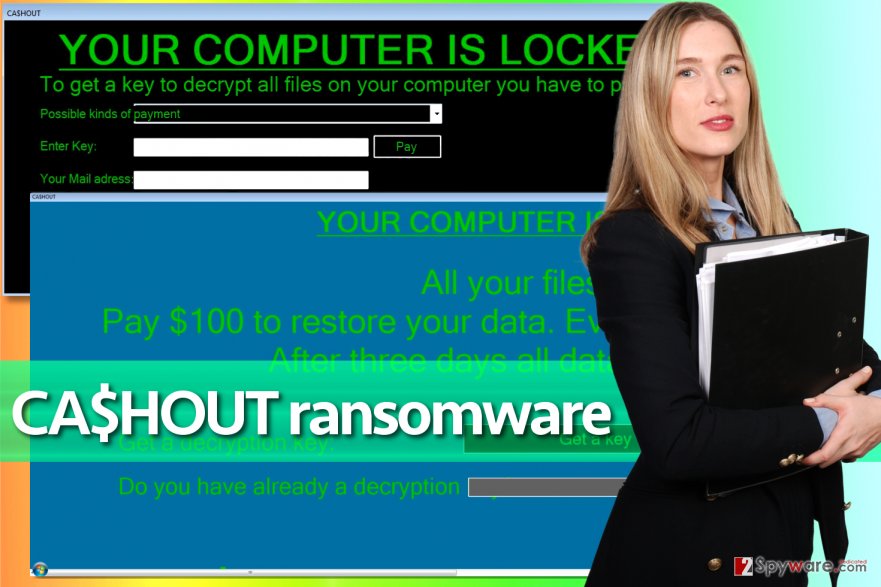CA$HOUT ransomware / virus (Improved Instructions) - Decryption Methods Included
CA$HOUT virus Removal Guide
What is CA$HOUT ransomware virus?
CA$HOUT ransomware doesn't function properly, but can be improved anytime
CA$HOUT ransomware is a badly developed computer virus that was created by an amateur. The name of the ransomware executable is called WindowsApplication1.exe, which means that the developer was using Visual Studio to create the ransomware. If the ransomware developer (whose name is Johannes) knew what WindowsForms are, then he definitely did not know a lot about encryption and programming in general. The ransomware launches a basic application that displays some text:
Your computer is locked
To get a key to decrypt all files on your computer, you have to pay $100
The ransomware suggests choosing from possible kinds of payment and asks to provide an email address. It seems that the virus is currently in test mode and the ransomware author might be trying to improve it. However, it is also possible that the ransomware is created by someone who hardly knows to code or simply is a teenager experimenting with open source ransomware codes found online[1]. No matter what, infecting your computer with CA$HOUT malware is something that should be prevented.

The ransomware doesn’t seem to be capable of scanning the entire computer system thoroughly – it only can detect files in certain folders. The application that the virus displays provides several buttons that do not seem to be working properly as well. Infecting the system with such amateur malware can corrupt some of your files for good – so it is better to protect yourself in advance. Luckily, the detection ratio of this virus is high, so a trustworthy anti-malware software will keep this virus away from your PC. If you do not have such program yet, we highly suggest installing FortectIntego. It can remove CA$HOUT as well as other malicious programs from your system in less than an hour.

Distribution of ransomware
Although it is unlikely that this ransomware will ever be distributed on a global scale, it is better to be aware of it and its distribution methods. As we can see, the ransomware is developed by a script kiddie who hardly knows how to code; therefore we assume that the only distribution technique Johannes is going to use is malicious spam[2]. It is the easiest technique that allows injecting malicious programs into computer systems with the help of social engineering – all that the attacker needs to do is to compose a convincing message and send it to the victim. Such message usually comes in tandem with a malicious URL or an email attachment that carries the malicious payload. Once opened, it downloads/launches ransomware.
Remove CA$HOUT malware without any hesitations
You do not have to waste your time wondering what to do and how to remove CA$HOUT virus. The guide given below explains how to remove the ransomware and what methods can help you to recover encrypted files. Keep in mind that ransomware developed by inexperienced programmers can be even more dangerous than professionally built viruses because it can act unpredictably. To delete the virus the right way, please read the provided CA$HOUT removal guidelines and follow them attentively.
Getting rid of CA$HOUT virus. Follow these steps
Manual removal using Safe Mode
It takes some time and patience to remove CA$HOUT virus, but every computer user can do it with a help of a good anti-malware software. In order to launch it, perform the system reboot using instructions given below.
Important! →
Manual removal guide might be too complicated for regular computer users. It requires advanced IT knowledge to be performed correctly (if vital system files are removed or damaged, it might result in full Windows compromise), and it also might take hours to complete. Therefore, we highly advise using the automatic method provided above instead.
Step 1. Access Safe Mode with Networking
Manual malware removal should be best performed in the Safe Mode environment.
Windows 7 / Vista / XP
- Click Start > Shutdown > Restart > OK.
- When your computer becomes active, start pressing F8 button (if that does not work, try F2, F12, Del, etc. – it all depends on your motherboard model) multiple times until you see the Advanced Boot Options window.
- Select Safe Mode with Networking from the list.

Windows 10 / Windows 8
- Right-click on Start button and select Settings.

- Scroll down to pick Update & Security.

- On the left side of the window, pick Recovery.
- Now scroll down to find Advanced Startup section.
- Click Restart now.

- Select Troubleshoot.

- Go to Advanced options.

- Select Startup Settings.

- Press Restart.
- Now press 5 or click 5) Enable Safe Mode with Networking.

Step 2. Shut down suspicious processes
Windows Task Manager is a useful tool that shows all the processes running in the background. If malware is running a process, you need to shut it down:
- Press Ctrl + Shift + Esc on your keyboard to open Windows Task Manager.
- Click on More details.

- Scroll down to Background processes section, and look for anything suspicious.
- Right-click and select Open file location.

- Go back to the process, right-click and pick End Task.

- Delete the contents of the malicious folder.
Step 3. Check program Startup
- Press Ctrl + Shift + Esc on your keyboard to open Windows Task Manager.
- Go to Startup tab.
- Right-click on the suspicious program and pick Disable.

Step 4. Delete virus files
Malware-related files can be found in various places within your computer. Here are instructions that could help you find them:
- Type in Disk Cleanup in Windows search and press Enter.

- Select the drive you want to clean (C: is your main drive by default and is likely to be the one that has malicious files in).
- Scroll through the Files to delete list and select the following:
Temporary Internet Files
Downloads
Recycle Bin
Temporary files - Pick Clean up system files.

- You can also look for other malicious files hidden in the following folders (type these entries in Windows Search and press Enter):
%AppData%
%LocalAppData%
%ProgramData%
%WinDir%
After you are finished, reboot the PC in normal mode.
Remove CA$HOUT using System Restore
-
Step 1: Reboot your computer to Safe Mode with Command Prompt
Windows 7 / Vista / XP- Click Start → Shutdown → Restart → OK.
- When your computer becomes active, start pressing F8 multiple times until you see the Advanced Boot Options window.
-
Select Command Prompt from the list

Windows 10 / Windows 8- Press the Power button at the Windows login screen. Now press and hold Shift, which is on your keyboard, and click Restart..
- Now select Troubleshoot → Advanced options → Startup Settings and finally press Restart.
-
Once your computer becomes active, select Enable Safe Mode with Command Prompt in Startup Settings window.

-
Step 2: Restore your system files and settings
-
Once the Command Prompt window shows up, enter cd restore and click Enter.

-
Now type rstrui.exe and press Enter again..

-
When a new window shows up, click Next and select your restore point that is prior the infiltration of CA$HOUT. After doing that, click Next.


-
Now click Yes to start system restore.

-
Once the Command Prompt window shows up, enter cd restore and click Enter.
Bonus: Recover your data
Guide which is presented above is supposed to help you remove CA$HOUT from your computer. To recover your encrypted files, we recommend using a detailed guide prepared by 2-spyware.com security experts.Data that the ransomware corrupted can be restored either from data backup or using one of the techniques described below.
If your files are encrypted by CA$HOUT, you can use several methods to restore them:
Data Recovery Pro
Data Recovery Pro software might help you to reverse the encryption:
- Download Data Recovery Pro;
- Follow the steps of Data Recovery Setup and install the program on your computer;
- Launch it and scan your computer for files encrypted by CA$HOUT ransomware;
- Restore them.
ShadowExploring
Shadow Explorer can help you to restore corrupted files using Volume Shadow Copies.
- Download Shadow Explorer (http://shadowexplorer.com/);
- Follow a Shadow Explorer Setup Wizard and install this application on your computer;
- Launch the program and go through the drop down menu on the top left corner to select the disk of your encrypted data. Check what folders are there;
- Right-click on the folder you want to restore and select “Export”. You can also select where you want it to be stored.
Finally, you should always think about the protection of crypto-ransomwares. In order to protect your computer from CA$HOUT and other ransomwares, use a reputable anti-spyware, such as FortectIntego, SpyHunter 5Combo Cleaner or Malwarebytes
How to prevent from getting ransomware
Do not let government spy on you
The government has many issues in regards to tracking users' data and spying on citizens, so you should take this into consideration and learn more about shady information gathering practices. Avoid any unwanted government tracking or spying by going totally anonymous on the internet.
You can choose a different location when you go online and access any material you want without particular content restrictions. You can easily enjoy internet connection without any risks of being hacked by using Private Internet Access VPN.
Control the information that can be accessed by government any other unwanted party and surf online without being spied on. Even if you are not involved in illegal activities or trust your selection of services, platforms, be suspicious for your own security and take precautionary measures by using the VPN service.
Backup files for the later use, in case of the malware attack
Computer users can suffer from data losses due to cyber infections or their own faulty doings. Ransomware can encrypt and hold files hostage, while unforeseen power cuts might cause a loss of important documents. If you have proper up-to-date backups, you can easily recover after such an incident and get back to work. It is also equally important to update backups on a regular basis so that the newest information remains intact – you can set this process to be performed automatically.
When you have the previous version of every important document or project you can avoid frustration and breakdowns. It comes in handy when malware strikes out of nowhere. Use Data Recovery Pro for the data restoration process.
- ^ MalwareTech. Why Open Source Ransomware is Such a Problem. MalwareTech Blog. Malware Reversing, IT Security News.
- ^ Darya Gudkova, Maria Vergelis, Nadezhda Demidova, Tatyana Shcherbakova. Spam and phishing in Q1 2017. Securelist. Information about Viruses, Hackers and Spam.





















